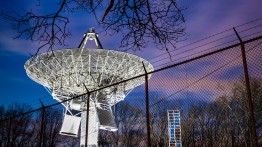Edwin King Stodola EE'36

As chief scientist of a five-man team of radar researchers in the U.S. Signal Corps, Edwin King Stodola (1914-1992) and his colleagues conducted an experiment in 1946 that has been credited with ushering in the Space Age. The team’s mandate had been to find out if radar could be used to detect incoming long-range missiles, a project informed by recent history: the vast destruction in England caused by Germany’s V-1 and V-2 missiles during World War II. The US feared it would suffer a similar fate at the hands of the Soviet Union, which had developed long-range missiles. The government turned to engineers at Fort Evans in Belmar, NJ, which included Stodola, who went to Brooklyn Tech for high school and then studied electrical engineering at Cooper. Previously, Stodola contributed to the war effort by developing radar that could detect kamikaze flights before an attack.
Stodola and the rest of the Fort Evans team took on the challenge, but initially suffered numerous setbacks. The group finally succeeded at hearing an echo from the radar they had launched from Earth as its waves bounced off the moon. Fittingly, they adopted a name for the project: Project Diana, after the Roman goddess of the moon. The breakthrough was front-page news and let the army track moving targets.
Essential to the experiment was an unusually tall antenna created from four standard radar antennas pointed towards the horizon where the moon would rise. The great height was needed in order to pick up the weak signal reflected back from the moon. On January 10th that year, the scientists recorded the pulse on an oscilloscope that showed the signal returned after approximately 2.5 seconds—which is the amount of time it takes for light to travel from Earth to the moon and back.
A year after that exceptional achievement, Stodola left the Signal Corps and worked for Reeves Instrument Corporation, a company that worked on radar and early computer projects for the government. During the 1970s, a long-range tracking system for radars that Mr. Stodola invented was used in NASA’s Project Mercury, the first U.S.-manned space program, and for the first air force surveillance satellite, Discoverer.
He received the Presidential Citation from The Cooper Union in 1987 and was inducted into The Cooper Union Hall of Fame in 2009.
Photo: Project Diana




